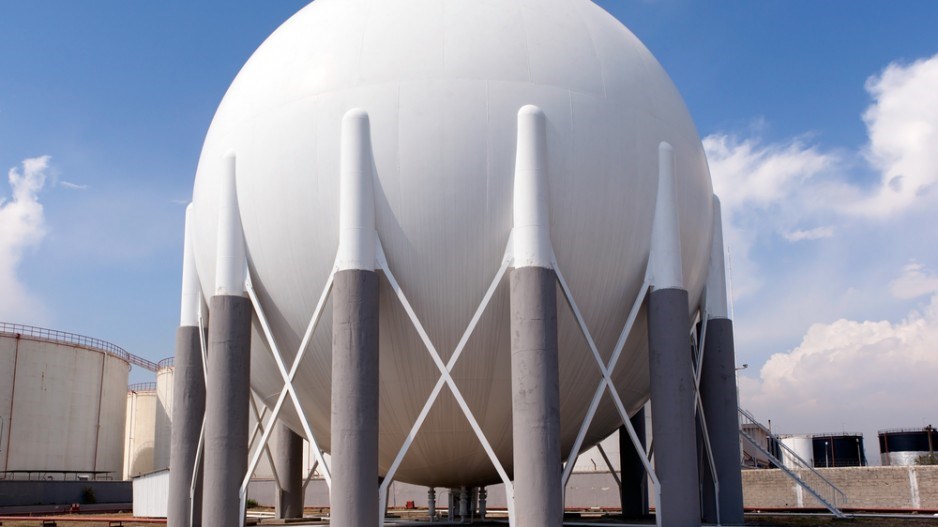Under the Liberal government, independent power producers prospered and the oil and gas sector entered the early stages of a boom that promises to create billions of dollars in wealth from oil pipelines and a new liquefied natural gas industry.
Gas and LNG
When the Liberals took power in 2001, B.C.'s natural gas sector was producing 2.5 billion cubic feet per day (Bcf/d).
Production in 2012 was a "robust" 3.2 Bcf/d, according to the Canadian Association of Petroleum Producers (CAPP).
"That represents significant production growth in the face of some very challenging economic times for natural gas," said Geoff Morrison, CAPP's manager of B.C. operations.
The Liberal government introduced a number of royalty incentive programs, and more recently – in an effort to help grow a liquefied natural gas industry – it changed definitions in its Clean Energy Act to classify natural gas as clean, if it's burned as part of the gas liquefaction process.
"The natural gas file was certainly something the government understood the value of and instituted some good policy to make B.C. a very competitive jurisdiction for investment," Morrison said.
Recently, however, the B.C. government threw the industry a curve ball with the announcement of the Prosperity Fund, which would create new taxes and royalties for LNG.
Morrison said B.C.'s oil and gas industry remains strong and is especially important for rural B.C. The biggest challenge for the industry is low natural gas prices, which have eroded profits for gas producers, and a shrinking market for Canadian gas in the U.S., which could soon be self-sufficient.
In addition to creating new markets for B.C. gas in Asia through LNG, Morrison said B.C. needs to expand the domestic market for natural gas – producing gas for electricity generation, for example, in provinces that still burn coal and encouraging the conversion of fleet vehicles to natural gas engines.
The oil and gas industry invests $4 billion to $6 billion in B.C. annually – a reflection of the competiveness of the jurisdiction, Morrison said.
"Broader economic challenges remain and will continue, highlighting the importance of market diversification and increasing domestic use of natural gas."
Oil
The B.C. government has been far less supportive of oil pipelines that would carry Alberta bitumen to the B.C. coast.
Two oil pipelines have been proposed for B.C.: the $6 billion Enbridge Inc. (TSX:ENB) Northern Gateway pipeline and the $4 billion Kinder Morgan Inc. (NYSE:KMY) Trans Mountain twinning project.
The Liberal government is not officially opposed to either project, although it has not given the Northern Gateway pipeline proposal an easy ride. Premier Christy Clark has said B.C. would assume 100% of the environmental risks associated with the pipeline but would receive only 8% of its benefits, and B.C.'s team of legal experts has been aggressively grilling Enbridge at the ongoing Joint Review Panel.
Although B.C. would not receive the royalties that Alberta would, the Canadian Energy Research Institute estimates B.C. stands to lose $4.7 billion in GDP that would accrue from the construction and operation of the Northern Gateway pipeline, if it is not built.
Power
Under the Liberal government, a boom in independent power production occurred, largely due to policy changes that encouraged investment by the private sector in small, renewable power projects – mostly wind and run-of-river – through the incentive of long-term power purchase agreements with BC Hydro. Many of the projects were done in partnership with First Nations.
But it's a boom that could come to an abrupt halt, thanks to a surplus of power.
Prior to 2001, there were 30 independent power producers (IPPs)throughout B.C., with an average size of only seven megawatts. At the time, B.C. was importing up to 15% of its needed power, according to the Clean Energy Association of British Columbia.
BC Hydro was directed to negotiate power agreements with the private sector, which resulted in "a complete transfer of execution risk and financing risk to the private sector," according to Clean Energy Association chairman Donald McInnes.
"Over the following six years, an industry was born and large and small new players entered B.C. with significant amounts of capital and proposals to help B.C. meet its growing electricity needs," McInnes said.
Calls for tenders were completed in 2006 and again in 2008.
"It took until 2010 to complete the call and by then most companies' data was stale and costs had risen significantly, leading to probable wide-scale attrition," McInnes said.
"Today the industry is in shambles in terms of certainty of being able to build more projects, which means virtually no risk capital is being spent on environmental baseline studies, engineering or feasibility work."
BC Hydro is now said to have a 10-year surplus of power. That could curb any further growth in the sector, which is also challenged by cheap natural gas. In addition, the sector is up against a public perception problem that IPPs are too expensive to continue subsidizing with power purchase agreements.
"Politicians do not seem to recall that building projects that can take up to a decade and will be in service for many decades are preferable [to] spot market purchases," McInnes said.
"The transfer of risk to the private sector is a good gain for government and BC Hydro, as the private sector is probably better suited to be efficient and accept risk. IPPs are in a far better position to work with First Nations as well."




